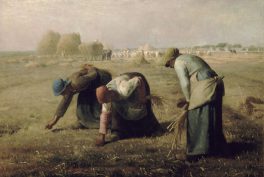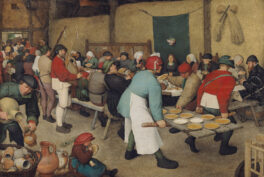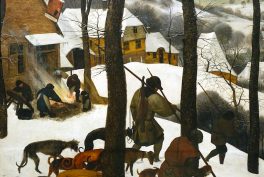Historical Background
Pieter Bruegel the Elder (ca. 1525-1569) is one of the most famous artists of the Northern Renaissance. His paintings explore the intertwined destiny of peasants and landscapes. Bruegel was so fascinated by the seasonal lives of peasants that he received the nickname “Peasant Bruegel” from teasing fellow artists. Bruegel was a humanist. He desired to explore the human condition through his visual images. He created philosophical landscapes where peasants either accept or fight their fate. They toil under the constraints and weariness of life, or they seek refuge and escapism through drunkenness and idleness. Bruegel’s painting, The Harvesters, is a masterpiece that explores this mortal drama through the highest levels of artistic sophistication.
General Composition
The Harvesters was painted in 1565, only four years before Bruegel’s death. It is an oil on wood measuring 119 x 162 cm (46 7/8 x 63 3/4 in). It depicts a harvest scene typically found in the late Summer of August or early Autumn of September. The painting was one of a six-part series representing the passage of seasons. One has been lost to time, while five are in museum collections globally. The Harvesters, in particular, is set at a specific time of the year. This is when peasants gathered together under the drowsy heat and reap the fields and fruit trees that have been tended all year round.
In the right foreground, peasants are eating and resting, perhaps taking their midday luncheon. In the left foreground are other peasants reaping the fields with large scythes. In the right midground are people bending and kneeling to collect grains and apples from the floor. Beyond the yellow field is a green pasture area. There, an ox is pulling a large bundle of stalks in the left, some people are swimming naked in the center, and others are playing some sort of village ball game in the right. Beyond the middle ground of green, is a background of another yellow field that is cut across by a pathway filled with horses and caravans.
Then, deeper still into the scene is a final, far background of a harbor on the right with full-rigged ships dotting the water. Pieter Bruegel the Elder easily captures five different planes in the painting, creating a panoramic view with a linear perspective. A great sense of depth and space is captured and presented before the viewer.
Luncheon
Everybody has to eat to live. It is one of the many commonalities that unite humanity. Also, generally speaking, the quality of the food, the quantity of it, and the designated time to eat it all impact how a person is socially viewed and judged. The rich and privileged eat very differently from the poor and disadvantaged.
Pieter Bruegel the Elder presents the viewer with a typical 16th-century Netherlandish peasant luncheon. Eight peasants are sitting on the ground to the right of the great tree in the foreground. Three are holding bowls filled with some whitish dish. The spoons in their hands suggest the meal is some sort of stew or pottage. Rice and potatoes were common dietary ingredients by the 1560s, and these two ingredients would definitely give any stew a whitish color.
Four peasants are eating bread. Two are cutting slices from large loaves while the other two are nibbling on slices. The third peasant is drinking beer or cider from a large terracotta carafe. All of their faces look content and fulfilled by their meal. It is a moment of nourishment and a break from their work day.
Naptime
To the left of where the luncheon is taking place, a man falls asleep. His mouth agape, the man sprawls his legs on the ground, with his right arm bent behind his head as a pillow. His black hat is slipping from his head but has now faded over time into a translucent gray mass revealing the right sleeve underneath. Clearly, Bruegel painted the hat as a final last-minute detail. Guessing from the presence of beer or cider at the luncheon, perhaps this man is drunk and has fallen asleep. He is most likely not returning to work until the following day.
Field Workers
Two people with large scythes are cutting and reaping the field in the left foreground. Their swaying movements are implied by the uneven line of their shoulders and the twist of their backs. They are men toiling in the field and fulfilling their work duties.
Beside them is a colleague carrying two large terracotta jars. Does he carry beer or cider to his coworkers?
Behind the three men are three women walking through the cut pathway. Two of them carry bundles of grain on their backs and shoulders. However, why isn’t the third woman carrying something? Perhaps she is, but it is not in the viewer’s line of sight.
Regardless, overall, there is a sense of community. The three men and three women are presented as idealized peasants. They are all hardworking, dutiful, and accepting of their position in life.
Collectors
In the right midground are people collecting foodstuff from the ground. A woman in a grey-green dress, a white cap, and a white apron is bending forward to collect a stack of grains in her arms. Her triangular body echoes the triangular bundles of grain standing on the empty ground beside her. She has become assimilated with agricultural life. Behind her is a man in red who is binding stalks together into bundles by tying rope. He will soon create another triangular pile.
Further to the right are two figures on their hands and knees collecting red apples lying on the ground. The discarded ladder beside them on the ground implies that one of them has just used that ladder to reach and shake apple branches to let apples rain down. Now, the ladder thrown aside, the two people gather the red fruit.
Ox and Caravans
In the left middle ground is a brown ox pulling a large yellow bundle of grain. Perhaps it is wheat or hay? Regardless, it looks cumbersome, and it is the cut product of the scene’s foreground. As a beast of burden, the ox is burdened with this load and slowly but steadily moves towards the right direction. A figure in gray follows the beast and guides it along its path.
Deeper into the scene is the yellow field of the middle ground. A yellow hill acts as a backdrop to the green grassy village. Sliced across the hill is a pathway, where figures and caravans descend. Perhaps they are moving towards the village to sell goods?
Nudity
In the central middle ground is a square lake dotted with nude figures. The viewer is seeing a 16th-century swimming party. Swimsuits, if they existed, were rarely owned or worn by peasants. They simply stripped nude and went into the water. Communal bathing was fairly common and there were no his and her pools. Men, women, boys, and girls all swam together nude as easily as they ate together clothed at the dinner table. Nudity was socially accepted in Medieval and Renaissance Western Europe. It did not have the strong social stigma or extreme sexualization of post-Victorian society.
Stoolball
Further to the right of the middle ground is a small village green dotted by about eleven people. They seem to be partaking in a ballgame, most likely the game of stoolball, which is the ancestor to both modern cricket and baseball. With its origins dating to the 14th century, Bruegel thus has captured a long tradition of communal village life. Like the communal swimming to the left, village peasant life was rarely solitary. Neighborly relationships and family ties were stronger and more intertwined than in today’s modern neighborhoods and towns.
Harbor
Further and deeper into the painting is the far background of a harbor. Its distance is implied by the hazy, foggy atmosphere that Bruegel has captured with his bluish tints and blurry outlines. Bruegel almost implies it is raining in the distance because the same bluish, blurry atmosphere is felt all along the horizon line. Perhaps a raincloud is approaching the foreground and will dampen the hardworking peasants?
Implications
Through the different activities, Pieter Bruegel the Elder truly reveals a microcosm of peasant life and how it interacts with the landscape. There is a palpable collective consciousness found in the weariness of the foreground and the frivolity of the middle ground. Typical peasant lives were split primarily into three activities: farm labor, church attendance, and recreational diversions. The viewer can see both work and play, but the religious side of life is only hinted at by the church in the right middle ground and by the biblical and moral implications found throughout the image.
There are many moralistic implications and biblical references in The Harvesters. The peasant luncheon features the idea of “give us our daily bread.” The man drunk and asleep is a reference to the sin of slothfulness and the wickedness of falling to temptations like alcohol.
Moreover, the women collecting fruit may allude to the forbidden fruit found in the Garden of Eden that led to the Expulsion of Adam and Eve. The composition of three men and three women resembles the virtues of hard work found in the Book of Proverbs. On the other hand, the swimmers farther away speak to the nakedness of the soul in the Final Judgement. Finally, the large tree in the foreground has dead branches and a withering truck from lack of care, which reflects how one’s soul may wither from laziness.
Stylistic Fusion
Pieter Bruegel the Elder captures all of these complex allusions and details with a sense of cosmopolitan worldliness by stylistically fusing the landscaping tradition of the Northern Renaissance with bright and vivid colors from the Venetian Renaissance.
Bruegel takes inspiration from previous Northern artists such as Albrecht Dürer, Hieronymus Bosch, and Matthias Grünewald. The figure placement and multi-layered depth these artists have a penchant for carry along in The Harvesters. In addition to these traditions, Bruegel infuses the vibrant primary colors found in the works of the Venetian School, such as Giovanni Bellini, Giorgione, and Titian. His visit to the Republic of Venice and access to many Venetian masterpieces enabled the latter attempt.
Artistic Brilliance
The Harvesters by Pieter Bruegel the Elder is a visual contemplation of human’s place in the world. It explores how figures interact with seasonal nature in almost the same vein as the Limbourg Brothers’ Très Riches Heures and other Books of Hours from the previous century. It presents an imaginary countryside but with realistic details and perspective to create an unidealized but believable landscape.
Shifting atmospheric effects dilute and reposition sunlight to evoke a sense of passing time and weather. Everything is in flux including human fate. However, what is not in flux is the superb status of The Harvesters as a masterpiece of the Northern Renaissance. It is an accomplished piece of seasonal art that stands as a constant testimony to the artistic brilliance of Pieter Bruegel the Elder.
That’s not al! This beautiful masterpiece is now available as a premium-quality print in DailyArt shop. Follow the link for more.

























